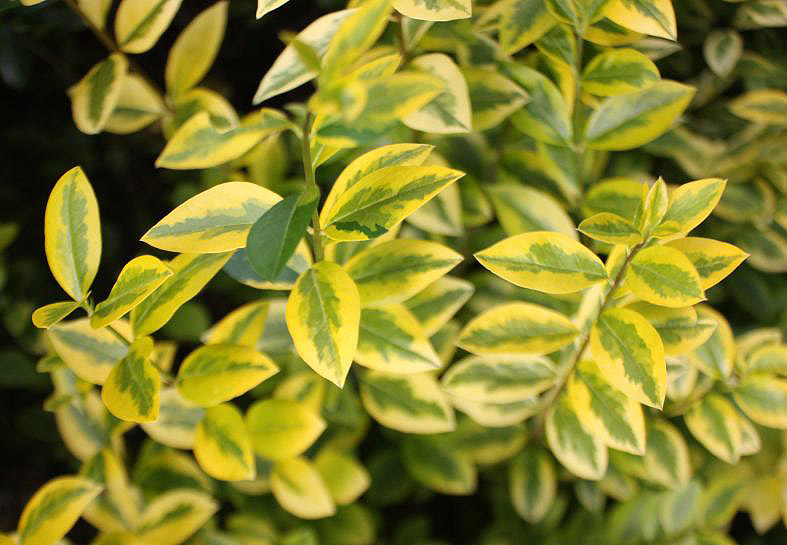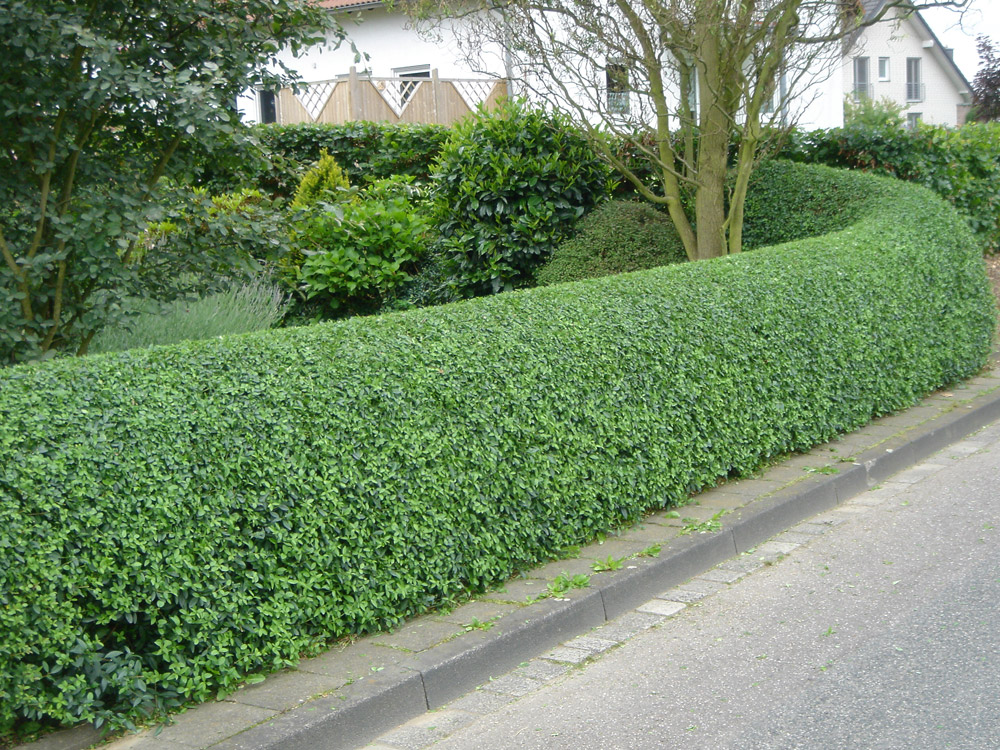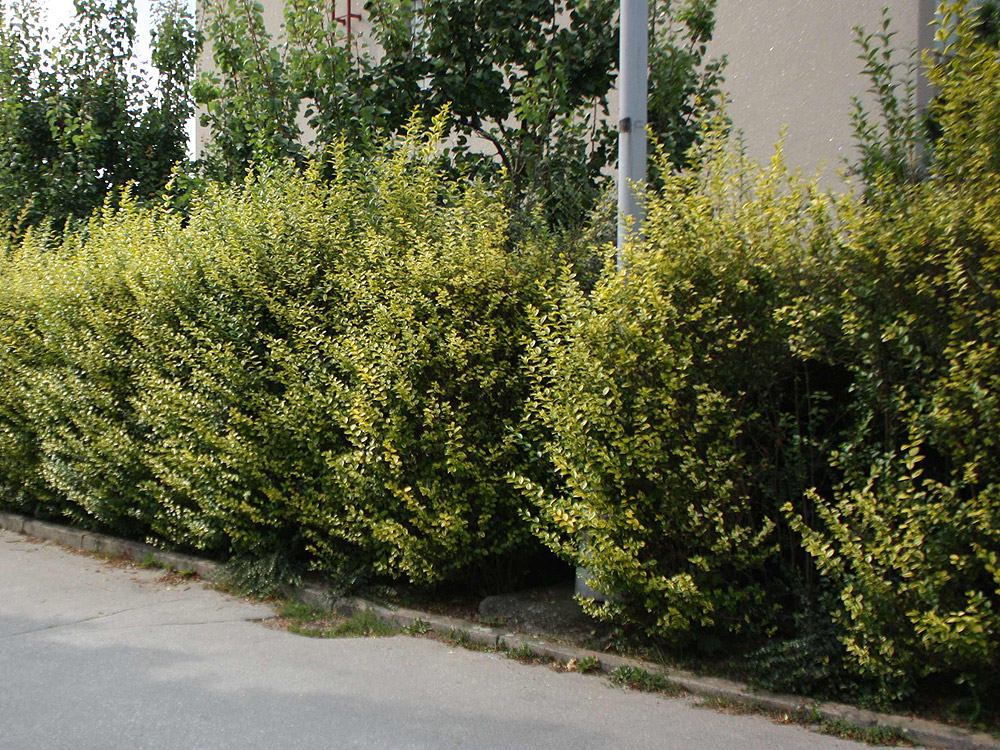Garden Plants, How
and where to grow them
Shrubs & Hedging
Privet, Ligustrum ovalifolium - Shrub
Privet is usually described as evergreen or semi-evergreen. It loses leaves in the winter, but not all of them and many remain so it generally appears evergreen, though not as fulsomely so in winter as summer
 Green privet is almost an obligate hedging plant in
that it must be kept cut otherwise it becomes very open and
loses its effect. Particularly good in windy areas
such as by the sea. The leaves are elliptical and dark green.
In lax hedges some shoots may flower and produce black fruit,
grows up to about 2m or more.
Green privet is almost an obligate hedging plant in
that it must be kept cut otherwise it becomes very open and
loses its effect. Particularly good in windy areas
such as by the sea. The leaves are elliptical and dark green.
In lax hedges some shoots may flower and produce black fruit,
grows up to about 2m or more.
There are variegated and yellow-leaved varieties available which are smaller than the green-leaved type, these can be used for hedging or topiary in the same way or as a part of a mixed border.
The yellow variety in particular, Ligustrum ovalifolium aureum, has wonderfully scented if fairly ordinary looking white flowers in the spring.
- Height and spread: 4m x 4m (12ft x 12ft)
- Position: full sun or partial shade, variegated varieties develop the best colour in full sun.
- Rate of growth: medium
- Hardiness: fully hardy
- Uses: Hedging / mixed border (variegated variety) / topiary / container topiary
- Planting distance when used for hedging: 30cm, 12"
- Clipped height: 1.5-3m, 5-10ft
- Number of times to clip per season and when: 2 - 3 growing season
- Pruning: Usually requires minimal pruning for specimens and in mixed plantings. Watch variegated and yellow-leaved varieties for all green shoots, these should removed completely or they will take over the whole plant.
- Responds to renovation?: Yes, cut whole plant back to 30cm, 12" of ground in spring to renovate, this may cause variegated or yellow leaved plants to revert completely to green however.
Questions about Privet, Ligustrum ovalifolium
Q. We have a very long privet hedge that skirts all three sides to our garden. It is about 3ft - 4 ft high but has got very wide and is encroaching on our beds too much. How and when do we prune it. We will need to prune hard, any tips on how we tackle it please.
A. Privet can take very hard pruning, so no real worries about damaging it. Leave it until it's showing signs of spring growth first though. I'd do it a side at a time, prune the side that is causing the greatest encroachment first, and then when that has greened up again, prune the other side. You can do both at the same time, but the plants then have to draw entirely on their reserves rather than being "powered" by the leafy side, the hedge also looks very threadbare until new leaves have grown.
Q. My privet hedge has been diagnosed as having a fungus or twig blight. My landscaper said I should cut this 10 foot row of shrubs down to 1 1/2 to 2 feet tall and it will grow back. Do you really think it will?
A. Privet can come back again strongly after being cut to ground level. Make sure you remove all traces that you cut back out of the garden or burn it all, don't compost it so as not to re-infect again. I'd also drench the area with a fungicide to help kill any residual fungus.
Q. Are there any climbing plants which will grow through a privet hedge and will withstand the usual clipping? Possibly a vigorous clematis or honeysuckle? I can't cut down my shared privet hedges but I desperately want to make them even the tiniest bit more attractive, especially as they have been cut back very hard this year as they'd been neglected in the past & look like twigs at the moment.
A. Some climbers such as those that
you mention will withstand the regular cutting that your privet
hedge will get if they grow through it, though I wouldn't
do it myself. The plant will almost certainly never flower,
or at least not as well as it would do otherwise. Whenever you
cut the hedge/climber you'll be removing resources that
could be put into flowering and possibly at some times of the
year, the flower buds themselves. Climbers growing through hedges
only work in a very informal setting with maybe a single annual
cut late in the year, situations where privet aren't really
planted. The good news on the other hand is that privet recovers
very well and very quickly from a severe cutting into bare wood.
Your hedge should be all bright and green again in much less
than the time it would take for a climber no matter how vigorous
to establish.
Q. We have a Privet
Hedge, approx 7 ft by 2-3 ft. Unsure of it's age. Early
spring after the spring growth had appeared, 2 plants curled
up & died. They had lost most of their leaves the
previous autumn, however when they sprouted in the spring we
thought all was OK. We had cleared all the ivy from around the
base of the plants the year before and thought maybe this had
had some effect. Now it seems that part of 2 other hedges are
also starting to die. They are not anywhere near the 2 plants
that died in the spring. Somebody suggested it was because of
a lack of water over the summer, however one of the hedges is
situated behind our herb garden and so was watered regularly
during the summer. The leaves now are a mix of dark purple /
red and yellow / brown. Some of the plants show some new green
growth, others don't. They appear to have thinned out quite
considerably too as we can now see through to the other side.
Some of the old wood has a green soft coating to it, like a
thin moss. Also a few months back I noticed some of the leaves
had curled up on themselves and turned black, with further investigation
I found a small cream coloured larva (3mm) inside the leaf walls
surrounded by what seemed to be digested black remains of the
inside of the leaf. I have not been able to find help anywhere
on what this might be. It doesn't leave tunnels like a leaf
miner, rather it just seems to eat everything in between the
2 walls. Please I don't know what to do next. I feel we
are in danger of losing all the hedge. It was last pruned late
spring / early summer and we've been afraid to touch it
since then. I have noticed a few other hedges in the district
looking somewhat the same, but there are others which look fantastic.
Is it worth putting down some Sequestered Iron or spraying with
a fungicide?
A. I think the leaf miners you found
are incidental rather than the cause of the problem, they are
not uncommon on privet. It sounds like either honey fungus or
wilt (a wonderfully vague term), both are fungal diseases that
will readily attack privet and cause the symptoms you describe
and over the time scale you describe. If it is honey fungus,
you should be able to find some of the bracket-like fruiting
bodies on the trunks of the plants. Wilt is caused by one of
a group of fungi that give no outward signs other than the symptoms
of the plant that is suffering. In either case there is little
you can really do directly. Cut out all of the dead wood and
stems and burn them, clean pruning tools carefully afterwards
so not to spread spores. Clear under the plants of weeds, ivy,
dead leaves and any other debris and give the hedge a top-dressing
of fish blood and bone meal lightly forked in to help build
up the strength. I have to say though that the outlook is not
very positive, particularly as you say other hedges in the area
are affected, it seems like the disease is endemic and may re-infect.
Try my suggestions, but be aware that you may eventually have
to replace the hedge with something that has resistance to the
disease that is affecting it.
Q. We have an established Privet Hedge of about 25ft in length. In the spring we noticed bare patches appearing and thought it may be spring scorch. How ever the bare patches have increased and now nearly the whole hedge has mauve/blackened leaves. We have checked for Honey Fungus and can find no sign of it. Some of the leaves show sign of a bug attack but we believe this is not connected. Any ideas on what is causing the bare patches?
A. Sounds very much like a fungus
of some kind, though difficult to tell without seeing it. Honey
fungus has sort of black "bootlaces" under the soil
and maybe under the bark too. The bugs sound like opportunists
on a struggling plant, privet have various insects that attack
them at the best of times. What to do depends on how far gone
it is, I'd strip the dead regions for signs of disease and
if they're dead, cut them right back to a healthy region.
Privet is good at recovering and responds well to severe pruning.
If it's able to be saved, take care with hygiene, remove
all prunings from the garden, burn them or take them down to
the tip. Sweep up leaves from the base of the plants and remove
these also. Give the hedge a boost with blood, fish and bonemeal
or gromore and a good mulch of garden compost or well rotted
farmyard manure. If it's really too late or it is honey
fungus and you have to remove the hedge, then replace with something
else instead and try to get rid of the roots too.
Q. We have an 30'
long, 8' high privet hedge that was being invaded by Buckthorn.
At first we let the Buckthorn "stay" as it
was very thick and provided a good screen from the neighbors.
But this year the Buckthorn overtook more of the privet, leading
us to cut and remove all of the Buckthorn. This has left us
with a hedge with some serious gaps in it. What suggestions
do you have to make the hedge come back at its fullest so that
it can return to 100% privet.
Also, I just planted 25 cheyenne
privet plants 2.5' apart to make a nice hedge on my lot
line. They are now about 3-4' high after being in the ground
about 2 months. When is the best time to prune, and how much
do we cut? We ideally want a 6' high square-topped hedge.
A. Fortunately privet responds well
to renovation. It seems the wrong thing to do, but you can stimulate
it into growth by trimming lightly in the areas that you want
to re-grow. Also give it a mulch if you have something available
in large quantities and a slow release fertiliser such as blood,
fish and bone meal. Also, watch out for re-growth of the buckthorn.
As for your new privet plants, I wouldn't touch them until
they're growing strongly in the spring, then trim lightly
to a neat shape and repeat every couple of months through the
summer. Imagine you're growing your hair long but want it
to always look well trimmed and groomed too!
Q. We have a very long, old privet hedge which we are trying to nurture back to full thickness. There is a lot of ivy growing at the bottom, should this be removed (it does provide some 'filler' at sparse bottom of hedge)?
A. Yes you should remove the ivy as it will choke the bottom of the hedge and grow up and compete with the privet if left. If there's any small twigs at the bottom, trim by them by about 1/3rd next spring which will stimulate them into growth. Privet is very good at growing again from brown wood, exposing it to light will help get it going - so remove the ivy.
Photo credits: (numbering left to right top to bottom) 1-Aureum5027 Public domain / 2-Holger Casselmann - Creative Commons Attribution 3.0 Unported license. / 3-I Sacek senior Li - Creative Commons Attribution 1.0 license. universal
Copyright 2000 - present. All Rights Reserved | Privacy Policy Statement


